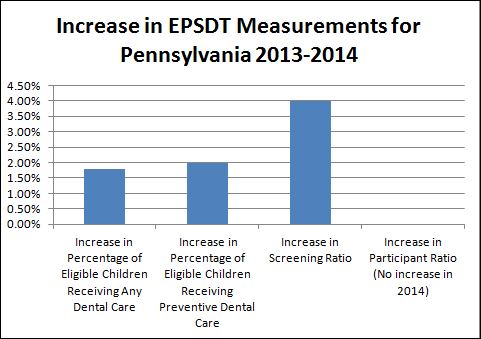2015 summer intern Will Bryer summarizes a report saying that Pennsylvania is failing to adequately provide Early Periodic Screening Diagnostic Treatment to its children.
The Center for Medicare & Medicaid Services (CMS) has released its Early Periodic Screening Diagnostic Treatment (EPSDT) data for 2014. This program provides children under 21, who are enrolled in Medicaid, with comprehensive and preventive medical and dental care.[i] They are entitled to periodic examinations by professionals, as well as screenings, diagnostic testing, evaluation and treatment of physical, mental, developmental, dental, hearing, and vision issues.[ii] All states that accept federal funds for Medicaid must provide EPSDT services to all eligible children, as well as report data about their program to CMS yearly. [iii]
The 2014 report shows that many states, including Pennsylvania, are failing to adequately provide EPSDT services to their children.[iv] A review of the data by the Public Interest Law Center shows that Pennsylvania trails a majority of states in providing adequate care to its 1,302,694 eligible children. It is imperative that Pennsylvania improve its participation rate and do a better job of providing adequate healthcare for its most vulnerable children.
Dental Care
Pennsylvania is continuing to fail to provide its children with adequate dental care, one of the most important aspects of EPSDT. Only 41.4% of Pennsylvania children eligible for EPSDT received any dental care of any kind, whether emergency of preventive, during 2014, leaving 763,826 children without any dental care at all. This is a slight increase from 39.6% in 2013, but still lags behind the national average of 44.0%, and leaves Pennsylvania in 35th place when it comes to providing any dental services.
EPSDT requires states to provide preventive dental care as well, which does not include eligible children who receive emergency dental care. Unfortunately, in 2014, only 37.6% of Pennsylvania children eligible for EPSDT receive preventive dental care. Once again, this falls short of the national average of 40.2%[v]. This places Pennsylvania in 36th place when it comes to providing preventive dental care to eligible children.
Participant Ratio
The participant ratio is included in the EPSDT data to measure the ratio of children who received a comprehensive medical evaluation to those that did not. Unfortunately, Pennsylvania’s participant ratio remained steady at .58, the same as 2013. This continues to place Pennsylvania just below the national average of .59. The continued failure to increase the percentage of eligible children receiving proper medical examinations is disheartening. This means that upwards of 547,000 eligible children in Pennsylvania failed to receive proper medical examinations during 2014.
Screening Ratio
The second major ratio that CMS provides is the Screening Ratio, which measures the number of examinations received by those eligible for EPSDT, divided by the number of screenings all eligibles should have received. Pennsylvania’s 2014 ratio of .73 is a significant improvement from its 2013 ratio of .69, however it is still below the national average of .79. This also ranks Pennsylvania behind a majority of states in their ability to provide adequate examinations to eligible children. Pennsylvania needs to do a better job ensuring that eligible children receive proper access to exams and screenings that are vital to good health.
Trends in the Data
Pennsylvania has shown minor increases in three of the four major measurement categories. This is positive news, but there is still a long way to go. Pennsylvania is still below that national average in all four major measurement categories. Even the national averages, however, are not high enough to ensure adequate healthcare for all children eligible for EPSDT.
Pennsylvania must do a better job of taking responsibility for the health of all of its young people and ensuring that they receive adequate healthcare.
——————————————————————————————————————–
[i] See, http://mchb.hrsa.gov/epsdt/overview.html
[ii] See, http://www.medicaid.gov/Medicaid-CHIP-Program-Information/By-Topics/Benefits/Early-and-Periodic-Screening-Diagnostic-and-Treatment.html
[iii] 42 U.S.C. § 1396 (d)(a)(4)(A). See, http://www.gpo.gov/fdsys/pkg/USCODE-2010-title42/pdf/USCODE-2010-title42-chap7-subchapXIX-sec1396d.pdf
[iv] All data has been taken from Medicaid.gov’s Early and Periodic Screening, Diagnostic, and Treatment Participation Reports, and can be accessed at: http://www.medicaid.gov/MEDICAID-CHIP-Program-Information/By-Topics/Benefits/Early-and-Periodic-Screening-Diagnostic-and-Treatment.html
[v] As of 7/31/2015, South Dakota, Maryland and New Hampshire still have not reported their data.





